
Perimeter Air Monitoring During the Cleanup of Former MGP Sites
To find out about our expertise in perimeter air monitoring during the cleanup of former MGP sites, please visit the following pages:
- Industry Need
- Atmos Energy Corporation Pioneers the ORS Technology
- Gas Technology Institute R&D Initiative
- Data-Management and Reporting Software
- Technical Paper Reprints

Open-Path FTIR Spectrometer at Atmos Energy’s Bristol MGP Site Cleanup
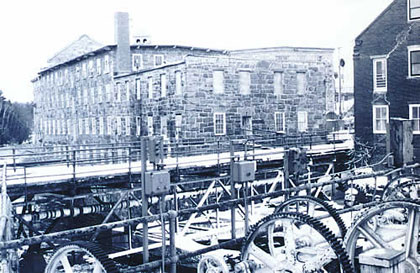
Old Mills MGP Site, Newmarket, New Hampshire: Before Cleanup
Today, the coal tars, light oils, and inorganic wastes typically found in the soil and groundwater around these plants are an environmental and public health concern. Most estimates place the number of former MGP sites still awaiting cleanup in this country at 3,000 or more. Local communities often believe that a significant potential for adverse health impacts exists during MGP site cleanups, and there are several pending and historical lawsuits alleging unacceptable exposure. Several factors contribute to site owners’ legal risk including proximity of MGP sites to the local community, perception of risk due to odors, and a highly visible party responding to site cleanups.

Old Mills MGP Site, Newmarket, New Hampshire: After Cleanup/Redevelopment
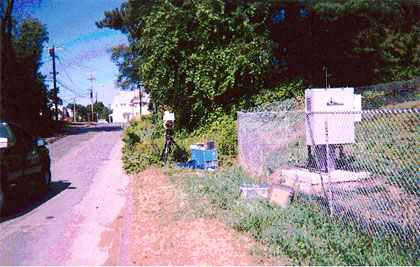
2002 FTIR Feasibility Study for EPRI at Massachusetts MGP Site Cleanup
ATMOS ENERGY CORPORATION PIONEERS
THE ORS TECHNOLOGY
Having completed several recent MGP site cleanups during which traditional, fixed-station point-monitoring was employed, Atmos Energy Corporation, in 2003, began researching optical remote sensing (ORS) as an air monitoring technology which could offer improved data quality and real-time reporting capabilities for a November 2004 MGP site cleanup in Bristol, Tennessee. Atmos Energy subsequently retained Minnich and Scotto to employ its ORS approach involving the use of open-path, Fourier-transform infrared (FTIR) spectroscopy in order to ensure that safe ambient air conditions were maintained at all times throughout the downwind Community during the site cleanup.
This innovative ORS technology was used to conclusively demonstrate, in real time, compliance with health-based, offsite air quality standards during all site-disturbance activities. A total of 14 target volatile organic compounds (VOCs) and polycyclic aromatic hydrocarbons (PAHs) were continuously monitored.

Truck Loading at Atmos Energy’s Bristol MGP Site Cleanup
On June 29, 2005, Atmos Energy Corporation was formally honored by its natural gas industry peers for utilizing the “eye that never sleeps” technology to monitor air emissions during its Bristol MGP site cleanup. At a ceremony held in Nashville, the Southern Gas Association (SGA) awarded Atmos Energy the “2005 Environmental Excellence New Technology Award” for its use of the open-path FTIR technology (click on Atmos News Release).
On February 12, 2007, SGA awarded Atmos Energy the “2007 Environmental Excellence Technology Award” for its continued efforts in forwarding the application of ORS technologies during MGP site cleanups. Atmos Energy received this prestigious award for its proposal to the Gas Technology Institute which led to: (a) development of an open-path ultraviolet (UV) spectrometer for use as a complementary monitoring tool; (b) development of Minnich and Scotto’s next-generation, data-management and reporting software; and (c) creation of a standard operating procedure for applying this approach to demonstrate Community protection during the cleanup of former MGP sites.
Although applied at several Superfund sites in the past, the Bristol site cleanup in 2004 marked the first time ORS-based perimeter monitoring of any type was employed to support an MGP site cleanup. Atmos Energy’s decision to use this technology was based on its capability of meeting the program objective when used together with onsite meteorological data. Additional advantages over traditional point monitoring cited by Atmos Energy were:
- Facilitation of real-time, field decision-making
- Elimination of spatial data-representativeness concerns by collecting concentration information along the entire downwind
perimeter, thus ensuring compounds could not leave the site undetected - Generation of a permanent, electronic record demonstrating maintenance of acceptable ambient air concentrations at all times
- Detection of target compounds of greatest concern to MGP site managers, such as naphthalene, benzene, and, where present,
hydrogen cyanide - Overall cost-effectiveness
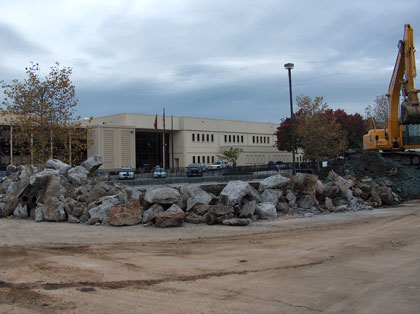
Sullivan County Court House
The most important reason for using this technology, however, was Atmos Energy’s unwavering commitment to being a responsible Community leader. Located just 30 meters to the east of the site was the Sullivan County Court House, the Bristol Police Station, and the Bristol Juvenile Detention Center. Atmos Energy’s enrollment of the Community in its commitment to do whatever was necessary to protect the air quality was integral to the ultimate success of the site cleanup. Not a single complaint was received.
Results of the perimeter monitoring program clearly demonstrated
that acceptable risk levels were maintained at all times. Despite the need to periodically slow down cleanup activities and implement mitigative measures, there was virtually no impact to the overall project timetable and the daily schedule for excavation and offsite waste hauling was never compromised. In fact, the perimeter monitoring program quickly became an integral part of the overall site management due to its capability of characterizing offsite impacts, in real time, as a function of cleanup activity.
Because Atmos Energy was first to use this technology to support an MGP site cleanup, they are eager to share their experience with other utility companies and consultants who face similar technical challenges and have a like commitment to Community and environmental excellence. Stuart Schulz, environmental specialist in charge of all of Atmos Energy’s MGP site cleanup work, has graciously offered to provide his perspective on the ORS approach and may be reached at [email protected].
Home
The Gas Technology Institute (GTI) is the leading research, development, and training organization serving the natural gas industry and energy markets. Many of the more than 3,000 MGP sites requiring cleanup in the US are owned by GTI member companies.
In January 2006, the Operations Technology Development (OTD) group, a consortium of utility companies, funded GTI to conduct a 26-month program, “ORS Methods Development for Perimeter Air Monitoring During MGP Site Cleanups.” Minnich and Scotto is GTI’s principal contractor in this endeavor. Our field operations consultant, Kassay Field Services, Inc. (www.kassay.com), is responsible for the operation of all ORS equipment as identified below.

Gas Technology Institute, Des Plaines, Illinois
The project is intended to gain necessary support from the US Environmental Protection Agency (USEPA) for the standardization and regulatory acceptance of our ORS-based, perimeter air monitoring approach for MGP site cleanups around the nation. Direct benefits to the natural gas industry include: facilitation of in-field, mitigative decision-making; elimination of adverse Community exposure; and minimization of legal risk to the site owners. Click on to GTI Focus Fact Sheet for a January 2007 description of this work.
Specific objectives are to:
- compare ORS-based and traditional point-monitoring approaches
- enhance PICMET-2 – Minnich and Scotto’s state-of-the-art, data-management and reporting software
- create a standard operating procedure (SOP)
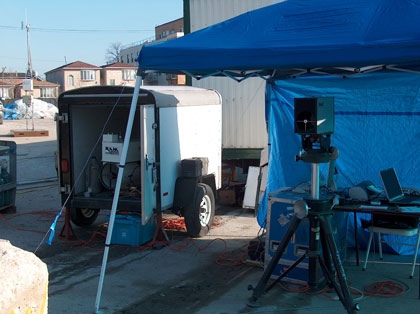
EDO FTIR and IMACC UV Spectrometers at First MGP Site Cleanup
Monitoring Approach Comparison
The monitoring approach comparison involves the simultaneous field testing (1 week) of open-path Fourier-transform infrared (FTIR), open-path ultraviolet (UV), and traditional pointmonitoring approaches at each of two former MGP sites during active cleanup.
The monitoring approaches are being evaluated in the context of likely end-user needs: facilitation of mitigative decision-making; real-time demonstration of acceptable Community risk; and assessment of long-term Community exposure. Emphasis is on benzene and naphthalene, the typically controlling contaminants, both of which are easily detected with each ORS instrument.
Traditional point monitoring is being performed in compliance with existing plans and protocols, and ORS monitoring is being performed in compliance with a program plan, monitoring plan, and quality assurance project plan. Of particular importance is the demonstration that the philosophy and guidance set forth in USEPA’s Data Quality Objective (DQO) process is followed throughout the planning and testing phase.
Data-Management And Reporting Software Enhancement
PICMET-2 enables continual, real-time assessment of compliance with 10-minute-averaged offsite action levels. The software employs the cross-sector averaging technique, conceived of by USEPA Region 7, and yields an average plume concentration across the beam (ppb) by dividing the path-integrated concentration (ppb-m) by the calculated plume width (m). Ten-minute-averaged offsite action levels are used as conservative proxies for 1-, 8-, or 24-hour acceptable ambient air concentrations.
Enhancements made under the GTI project include:
- operating system conversion from EXCEL to MS Windows-based client/server application
- the capability for automatic entry of all data directly from the FTIR and UV spectrometers
- more sophisticated reporting and documentation capabilities
The SOP provides a straightforward ORS-based methodology for generating legally admissible data which ensures compliance with applicable offsite health criteria during the cleanup of former MGP sites. Prepared in conformance with applicable USEPA guidance, the SOP is designed to ensure that data-collection efficiency is optimized, thereby resulting in a reduced work effort and the generation of data of the highest quality. The SOP empowers the site owner in being proactive with a highly cost-effective approach for simultaneously managing the cleanup and the attendant legal risk, and ensures methods standardization and application consistency from site to site.
Project Evaluation Commitee
Objectivity is inherent through the creation and integral involvement of a diverse Evaluation Committee beginning at the planning level and spanning the duration of the project. The Committee is comprised of representatives drawn from the following project stakeholders: GTI, OTD member companies, Baker & McKenzie (outside legal counsel), USEPA Office of Research & Development (ORD), USEPA Office of Air Quality Planning and Assessment (OAQPS), USEPA National Environmental Response Team (ERT), the Illinois EPA, the New York State Department of Environmental Conservation (NYSDEC), and the New York State Department of Health (NYSDOH).

GTI’s Vision
The project is a markedly visible demonstration of GTI’s ongoing commitment to provide unparalleled service to the natural gas industry.This breakthrough technology reinvents the management of former MGP site cleanups worldwide by revolutionizing how perimeter air monitoring is performed. It is GTI’s vision that the legal and political roadblocks to the effective, expeditious cleanup of MGP sites are eliminated, and that each cleanup is performed within a “partnership triangle” comprised of the site owner, responsible regulators, and the local Community.
DATA-MANAGEMENT AND REPORTING SOFTWARE
PICMET-2 (Path-Integrated Concentration - Meteorology software) is Minnich and Scotto’s state-of-the-art computer program for managing its perimeter air monitoring during former MGP site cleanups.
PICMET-2 employs the cross-sector averaging technique, conceived of by USEPA Region 7, to automatically generate maximum offsite concentrations for contaminants of concern based on the spectroscopic measurements and onsite meteorology. This technique involves the collection of path-integrated, crosswind contaminant measurement data downwind of the source (concentration units of parts per million times meters, ppm-m, or milligrams per square meter, mg/m2), and then dividing each concentration by the plume width (m) to yield a representative maximum impact along the spectrometer beam (ppm or mg/m3). It provides a conservative methodology for assessing the maximum 10-minute-averaged concentration at any downwind location.
A dilution factor is applied to the maximum beam impact to account for the increasing contaminant “loss” due to atmospheric dispersion as the plume moves away from the site toward the downwind receptor(s). The dilution factor is based on a full array of dispersion modeling performed for all source-beam-receptor relationships and meteorological conditions expected to occur.
The identification of an appropriate plume width depends on three factors: (a) dispersive properties of the plume as it is transported along the mean wind direction; (b) the distance between the source and the spectrometer beam; and (c) the width of the source itself (e.g., excavation area or stockpiled material). Physical dimensions and source-receptor distances are entered manually, while PICMET-2 automatically retrieves and processes all spectroscopic and requisite meteorological data for each 10-minute monitoring event.
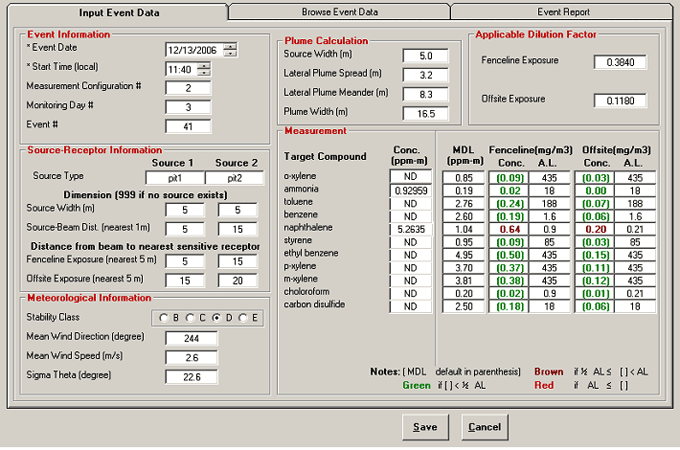
Sample PICMET-2 Data Screen
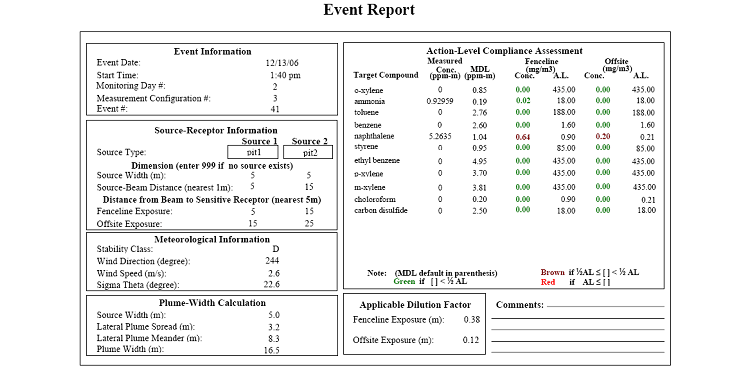
Sample PICMET-2 Event Report
Minnich and Scotto has already begun design of PICMET-3, which will feature expanded reporting capabilities such as a graphical depiction of cumulative exposure (dosage) throughout the Community, and a tabular or graphical presentation of maximum offsite impacts (daily or project) as a function of site activity or meteorology, on a compound-specific basis. It will enable a graphical base map display to be incorporated, thereby virtually eliminating the need for manual data entry.
TECHNICAL PAPER REPRINTS
Click on MGP Site Perimeter Air Monitoring for access to reprints of selected technical papers on this topic. Each paper is either authored or co-authored by Timothy Minnich and/or Robert Scotto.
Home
© 2007 Minnich and Scotto, Inc.